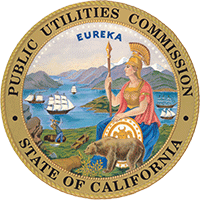What is Cost of Capital (CoC)?
A utility’s Rate of Return (ROR), or Cost of Capital (CoC), is the weighted average cost of debt, preferred equity, and common stock a utility has issued to finance its utility capital investments. Cost of debt is determined by weighted average interest rates on long-term debt issuances while the cost of common stock is expressed as the Return on Equity (ROE). ROE represents the financial return to shareholders that invest in common stock and is expressed as a percentage. The Commission attempts to set the authorized ROE at a level that is adequate to enable the utility to attract investors to finance the replacement and expansion of its facilities so it can fulfill its public utility service obligation. In practice, the authorized ROE level is determined in Commission proceedings by examining various financial models and estimating market returns on investments for other companies with similar levels of risk.
R.87-11-012 established an annual CoC proceeding separate from General Rate Cases (GRCs) for the major California utilities beginning January 1, 1990. In 2008, Decision (D).08-05-035 established a Cost of Capital Mechanism (CCM) for PG&E, SCE, SDG&E and SoCalGas (the Utilities) which enabled CoC applications to be filed triennially in a single consolidated proceeding instead of annually. The CCM provides for an automatic adjustment to a utility’s CoC in between the triennial filings if a certain threshold based on utility bond index rate changes is met.
The Utilities’ CoC received a thorough review in 2012 in Decision (D.)12-12-034. In 2015, 2016 and 2017, the utilities requested and were granted extension waivers from filing CoC applications. In 2017, the Utilities filed a joint petition to modify D.12-12-034 requesting to reduce the authorized ROE, update cost of debt, and delay the next full Cost of Capital proceeding until 2019. Consistent with the resulting D.17-07-005, the Utilities filed test year 2020 CoC applications on April 22, 2019. These applications resulted in D.19-12-056 which set the Utilities’ cost of capital for 2020-2022. The Utilities filed unexpected off-cycle 2022 CoC applications, as well as the scheduled 2023 CoC applications. D.22-11-018 resolved the 2022 off-cycle applications, while D.22-12-031 adopted the cost of capital for the Test Year 2023 three-year cycle and directed a second phase of the proceeding.
Most recently, the Utilities’ CoC were adjusted for 2024 due to the triggering of the CCM when the designated bond index threshold was met during the measurement period. The resulting Energy Division Resolution E-5306 authorized the 2024 CoC for the Utilities. For 2025, the Utilities’ CoC were adjusted due to modifications to the CCM ordered by Commission decision D.24-10-008 resolving the second phase of the TY 2023 CoC proceeding. In March 2025, the Utilities filed Test Year 2026 CoC Applications A.25-03-010, A.25-03-012, A.25-03-013, and A.25-03-011.
It is important to note that cost of service regulation does not guarantee utilities will earn an authorized ROR. A utility's actual or recorded ROR may be higher or lower than what the Commission has authorized, depending on how the utility manages its costs. This provides an incentive for utilities to efficiently manage their operating costs.
For current and historical CoC data, click here

